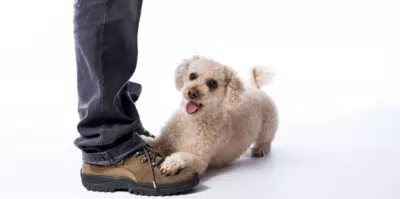Why Do Dogs Bury Things?
- 12 Sep 2023
- 4m read
.jpeg)
Welcome to a paw-sitively fascinating exploration into the intriguing world of our furry friends and their curious habit of burying things.
Why Do Dogs Bury Bones and Toys?
Dogs burying bones and toys is a behaviour deeply rooted in their ancestral past. In the wild, their ancestors would often bury leftover food to hide it from scavengers or save it for later. This instinctual behaviour still lingers in our domesticated pups, even if their kibble is readily available.
Instinctual behaviour
Dogs have a natural instinct to bury things as a way of protecting their precious possessions. This goes back to their days as hunters and scavengers, when they needed to safeguard their food from potential thieves.
Sensory appeal
Burying objects like bones and toys can also enhance their scent. Dogs have an extraordinary sense of smell, and by burying their treasures, they create a sensory playground that appeals to their olfactory senses.
Comfort and security
Just like humans find comfort in familiar surroundings, dogs feel secure when they have their favourite items close by. Burying a cherished bone or toy might be their way of ensuring it's always within reach.
Why Do Dogs Bury Things in Blankets?
Have you ever caught your pup tucking their toys or treats beneath a blanket? This behaviour adds an adorable twist to their burying habits, and it's not without reason.
Mimicking maternal instincts
One theory suggests that dogs bury things in blankets or bedding to mimic the actions of their mother. In the wild, a mother dog might dig a shallow hole in the ground to create a nest for her puppies. Burying objects in soft materials like blankets could be a manifestation of this maternal instinct.
Concealment
Blankets provide a cosy, soft environment, which can make for an ideal hiding spot. It also conceals the item, making it less visible and, in the dog's mind, safer from potential threats.
Reducing stimuli
Dogs are sensitive to their surroundings, and sometimes they bury things in blankets as a way of reducing visual and tactile stimuli. It's like creating a little safe haven in the midst of a busy environment.
Why Do Dogs Bury Things with Their Nose?
Ever noticed your dog using their nose to dig and bury things? This behaviour adds an extra layer of intrigue to their burying habits.
Enhanced scent marking
Dogs have scent glands in their paws and noses. When they use their noses to bury items, they leave behind their scent. This could serve as a form of territorial marking, indicating to other dogs that this spot and its buried treasures belong to them.
Natural digging instinct
Dogs are born with a natural digging instinct. In the wild, they might dig to find food, create a den, or cool off in hot weather. Burying things with their nose taps into this instinctual behaviour.
Enjoyment and stimulation
Digging and burying things can be mentally and physically stimulating for dogs. It's like a fun puzzle game for them, engaging their senses and providing a sense of accomplishment.
Do Dogs Remember Where They Bury Things?
Ah, the million-collar question. Do dogs have a built-in GPS system for their buried treasures? Let's find out.
It varies from dog to dog
Just like humans have varying degrees of memory, so do dogs. Some dogs have an uncanny ability to remember the exact location of buried items, while others may forget within minutes.
Scent plays a role
Dogs primarily rely on their keen sense of smell to locate buried items. If the scent of the buried object is strong and unique, they are more likely to remember its location.
Trial and error
Dogs may engage in a bit of trial and error when searching for buried items. They might dig in different spots until they stumble upon their hidden treasure. Pet detectorists.
Hiding places matter
If a dog buries something in a place with distinct landmarks, they may have a better chance of finding it later. However, if it's buried in a generic location, retrieval becomes more challenging.




.png)